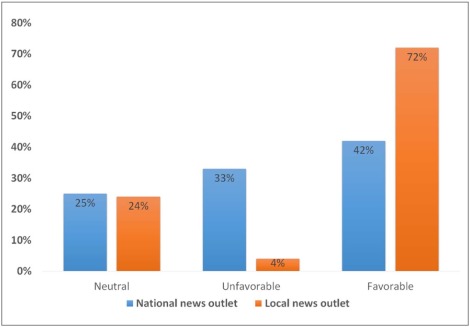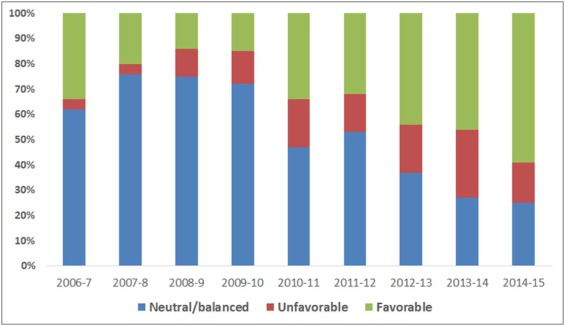Rationale and Objectives
To characterize online news coverage relating to mammography, including articles’ stance toward screening mammography.
Materials and Methods
Google News was used to search U.S. news sites over a 9-year period (2006–2015) based on the search terms “mammography” and “mammogram.” The top 100 search results were recorded. Identified articles were manually reviewed.
Results
The top 100 news articles were from the following sources: local news outlet (50%), national news outlet (24%), nonimaging medical source (13%), entertainment or culture news outlet (6%), business news outlet (4%), peer-reviewed journal (1%), and radiology news outlet (1%). Most common major themes were the screening mammography controversy (29%), description of a new breast imaging technology (23%), dense breasts (11%), and promotion of a public screening initiative (11%). For the most recent year, article stance toward screening mammography was 59%, favorable; 16%, unfavorable; and 25%, neutral. After 2010, there was an abrupt shift in articles’ stances from neutral to both favorable and unfavorable.
Conclusions
A wide range of online news sources addressed a range of issues related to mammography. National, rather than local, news sites were more likely to focus on the screening controversy and more likely to take an unfavorable view. The controversial United States Preventive Services Task Force guidelines may have influenced articles to take a stance on screening mammography. As such online news may impact public perception of the topic and thus potentially impact guideline adherence, radiologists are encouraged to maintain awareness of this online coverage and to support the online dissemination of reliable and accurate information.
Introduction
On November 16, 2009, the United States Preventive Services Task Force (USPSTF) released a recommendation that screening mammography be performed in average-risk women on a biannual basis from age 50 to 74 . This recommendation differed from guidelines by the American College of Radiology, American Cancer Society, and American College of Obstetricians and Gynecologists . The conflicting guidelines have engendered significant controversy and debate in the field while creating confusion for patients and primary care providers. This ongoing controversy has also received considerable attention from a multitude of news sources, whether at the local or national level. Celebrities and other public figures have also contributed to the public discourse, for example, by sharing their personal experiences regarding breast cancer and breast cancer screening . Such news coverage and other forms of public discourse have the potential to impact patients’ and policymakers’ views of screening mammography, as well as patients’ likelihood to undergo the examination. The aim of this study is to characterize recent online news coverage relating to mammography, as well as explore the potential impact of the 2009 USPSTF guidelines on such online news articles’ stance regarding the screening mammography controversy.
Materials and Methods
This study did not use private identifiable information and thus did not represent human subjects research.
Get Radiology Tree app to read full this article<
Get Radiology Tree app to read full this article<
Get Radiology Tree app to read full this article<
Get Radiology Tree app to read full this article<
Results
Get Radiology Tree app to read full this article<
TABLE 1
Predominant Themes of the Top 100 Online News Articles on Mammography in the Most Recent Year of Search of Google News
Theme Percentage of Articles (%) The screening mammography controversy 29 Describing a new breast imaging technology 25 Dense breasts issue 11 Promoting public screening initiatives 11 Patient experience 6 Mammography market projections 4 Complication from getting a mammogram 2 Radiation risks 2 Celebrity undergoing a mammogram 2 Poor quality of a given facility 2
Get Radiology Tree app to read full this article<
Get Radiology Tree app to read full this article<
Get Radiology Tree app to read full this article<
Get Radiology Tree app to read full this article<
Get Radiology Tree app to read full this article<
Discussion
Get Radiology Tree app to read full this article<
Get Radiology Tree app to read full this article<
Get Radiology Tree app to read full this article<
Get Radiology Tree app to read full this article<
Get Radiology Tree app to read full this article<
Get Radiology Tree app to read full this article<
References
1. U.S. Preventive Services Task Force : Screening for breast cancer: U.S. Preventive Services Task Force recommendation statement. Ann Intern Med 2009; 151: pp. 716-726. w-236
2. U.S. Preventive Services Task Force: Recommendations and Rationale : Screening for breast cancer: recommendations and rationale. Ann Intern Med 2002; 137: pp. 344-346.
3. Oeffinger K.C., Fontham E.T., Etzioni R., et. al.: Breast cancer screening for women at average risk: 2015 guideline update from the American Cancer Society. JAMA 2015; 314: pp. 1599-1614.
4. American College of Obstetricians-Gynecologists : Practice bulletin no. 122: breast cancer screening. Obstet Gynecol 2011; 118: pp. 372-382.
5. Borzekowski D.L., Guan Y., Smith K.C., et. al.: The Angelina effect: immediate reach, grasp, and impact of going public. Genet Med 2014; 16: pp. 516-521.
6. Kelaher M., Cawson J., Miller J., et. al.: Use of breast cancer screening and treatment services by Australian women aged 25–44 years following Kylie Minogue’s breast cancer diagnosis. Int J Epidemiol 2008; 37: pp. 1326-1332.
7. Haneef R., Lazarus C., Ravaud P., et. al.: Interpretation of results of studies evaluating an intervention highlighted in Google Health News: a cross-sectional study of news. PLoS ONE 2015; 10: pp. e0140889.
8. Dasgupta N., Mandl K.D., Brownstein J.S.: Breaking the news or fueling the epidemic? Temporal association between news media report volume and opioid-related mortality. PLoS ONE 2009; 4: e7758
9. Noar S.M., Ribisl K.M., Althouse B.M., et. al.: Using digital surveillance to examine the impact of public figure pancreatic cancer announcements on media and search query outcomes. J Natl Cancer Inst Monogr 2013; 2013: pp. 188-194.

